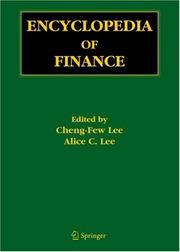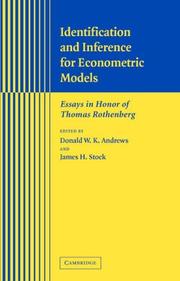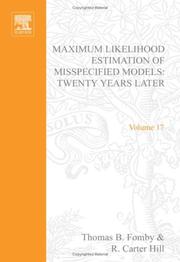| Listing 1 - 10 of 356 | << page >> |
Sort by
|
Periodical
Year: 2000 Publisher: New Brunswick, NJ : Transaction Periodicals Consortium
Abstract | Keywords | Export | Availability | Bookmark
 Loading...
Loading...Choose an application
- Reference Manager
- EndNote
- RefWorks (Direct export to RefWorks)
Economics --- Econometrics --- Methodology --- Économie politique --- Économétrie --- Méthodologie
Periodical
Year: 2005 Publisher: Istanbul : Istanbul Universitesi, Iktisat Fakultesi
Abstract | Keywords | Export | Availability | Bookmark
 Loading...
Loading...Choose an application
- Reference Manager
- EndNote
- RefWorks (Direct export to RefWorks)
Econometrics --- Statistics --- Economic Theory --- Économétrie --- Statistique

ISBN: 9780387263366 0387263365 Year: 2006 Publisher: New York, N.Y. : Springer,
Abstract | Keywords | Export | Availability | Bookmark
 Loading...
Loading...Choose an application
- Reference Manager
- EndNote
- RefWorks (Direct export to RefWorks)
This project will have a stamped cover, therefore no back text can be used.
Macroeconomics --- Quantitative methods (economics) --- Finance --- macro-economie --- financiën --- econometrie
Multi
ISBN: 9783031052026 9783031052019 9783031052033 9783031052040 Year: 2022 Publisher: Cham, Switzerland : Springer,
Abstract | Keywords | Export | Availability | Bookmark
 Loading...
Loading...Choose an application
- Reference Manager
- EndNote
- RefWorks (Direct export to RefWorks)
This book provides a practical introduction to mathematics for economics using R software. Using R as a basis, this book guides the reader through foundational topics in linear algebra, calculus, and optimization. The book is organized in order of increasing difficulty, beginning with a rudimentary introduction to R and progressing through exercises that require the reader to code their own functions in R. All chapters include applications for topics in economics and econometrics. As fully reproducible book, this volume gives readers the opportunity to learn by doing and develop research skills as they go. As such, it is appropriate for students in economics and econometrics.
Statistical science --- Quantitative methods (economics) --- statistiek --- econometrie --- Economics --- Mathematical models.
Multi
ISBN: 9781484274347 9781484274330 9781484274354 9781484283707 1484274342 Year: 2022 Publisher: California : Apress L. P.,
Abstract | Keywords | Export | Availability | Bookmark
 Loading...
Loading...Choose an application
- Reference Manager
- EndNote
- RefWorks (Direct export to RefWorks)
Get up to speed on the application of machine learning approaches in macroeconomic research. This book brings together economics and data science. Author Tshepo Chris Nokeri begins by introducing you to covariance analysis, correlation analysis, cross-validation, hyperparameter optimization, regression analysis, and residual analysis. In addition, he presents an approach to contend with multi-collinearity. He then debunks a time series model recognized as the additive model. He reveals a technique for binarizing an economic feature to perform classification analysis using logistic regression. He brings in the Hidden Markov Model, used to discover hidden patterns and growth in the world economy. The author demonstrates unsupervised machine learning techniques such as principal component analysis and cluster analysis. Key deep learning concepts and ways of structuring artificial neural networks are explored along with training them and assessing their performance. The Monte Carlo simulation technique is applied to stimulate the purchasing power of money in an economy. Lastly, the Structural Equation Model (SEM) is considered to integrate correlation analysis, factor analysis, multivariate analysis, causal analysis, and path analysis. After reading this book, you should be able to recognize the connection between econometrics and data science. You will know how to apply a machine learning approach to modeling complex economic problems and others beyond this book. You will know how to circumvent and enhance model performance, together with the practical implications of a machine learning approach in econometrics, and you will be able to deal with pressing economic problems. What You Will LearnExamine complex, multivariate, linear-causal structures through the path and structural analysis technique, including non-linearity and hidden statesBe familiar with practical applications of machine learning and deep learning in econometricsUnderstand theoretical framework and hypothesis development, and techniques for selecting appropriate modelsDevelop, test, validate, and improve key supervised (i.e., regression and classification) and unsupervised (i.e., dimension reduction and cluster analysis) machine learning models, alongside neural networks, Markov, and SEM modelsRepresent and interpret data and models Who This Book Is ForBeginning and intermediate data scientists, economists, machine learning engineers, statisticians, and business executives
Quantitative methods (economics) --- Programming --- Python (informatica) --- econometrie --- Econometrics. --- Quantitative research.

ISBN: 052184441X 9780521844413 9780511614491 9780521154741 0511115695 9780511115691 0511614497 1280162287 9781280162282 1107151937 0511122128 0511198523 0511299427 0511115148 052115474X Year: 2005 Publisher: Cambridge ; New York : Cambridge University Press,
Abstract | Keywords | Export | Availability | Bookmark
 Loading...
Loading...Choose an application
- Reference Manager
- EndNote
- RefWorks (Direct export to RefWorks)
This 2005 volume contains the papers presented in honor of the lifelong achievements of Thomas J. Rothenberg on the occasion of his retirement. The authors of the chapters include many of the leading econometricians of our day, and the chapters address topics of current research significance in econometric theory. The chapters cover four themes: identification and efficient estimation in econometrics, asymptotic approximations to the distributions of econometric estimators and tests, inference involving potentially nonstationary time series, such as processes that might have a unit autoregressive root, and nonparametric and semiparametric inference. Several of the chapters provide overviews and treatments of basic conceptual issues, while others advance our understanding of the properties of existing econometric procedures and/or propose others. Specific topics include identification in nonlinear models, inference with weak instruments, tests for nonstationary in time series and panel data, generalized empirical likelihood estimation, and the bootstrap.
330.115 --- Econometrie --- 330.115 Econometrie --- Econometric models --- Econometrics --- Mathematical models --- Econometric models. --- Modèles économétriques --- Business, Economy and Management --- Economics

ISBN: 0762310758 9786611028121 1281028126 1849502536 0080547427 9780080547428 9781849502535 9780762310753 9781281028129 6611028129 Year: 2003 Publisher: Amsterdam ; Boston : Elsevier/JAI,
Abstract | Keywords | Export | Availability | Bookmark
 Loading...
Loading...Choose an application
- Reference Manager
- EndNote
- RefWorks (Direct export to RefWorks)
This volume is the result of an Advances in Econometrics conference held in November of 2002 at Louisiana State University in recognition of Halbert White's pioneering work published in Econometrica in 1980 and 1982 on robust variance-covariance estimation and quasi-maximum likelihood estimation. It contains 11 papers on a range of related topics including the estimation of possibly misspecified error component and fixed effects panel models, estimation and inference in possibly misspecified quantile regression models, quasi-maximum likelihood estimation of linear regression models with bounded and symmetric errors and quasi-maximum likelihood estimation of models with parameter dependencies between the mean vector and error variance-covariance matrix. Other topics include GMM, HAC, Heckit, asymmetric GARCH, Cross-Entropy, and multivariate deterministic trend estimation and testing under various possible misspecifications.
Mathematical statistics --- 330.115 --- 330.115 Econometrie --- Econometrie --- Econometric models --- Econometrics --- Economics, Mathematical --- Statistics --- Mathematical models --- Econometrics. --- Econometric models. --- Business & Economics
Book
ISBN: 9783030581312 9783030581329 9783030581336 9783030581305 3030581330 3030581306 3030581314 Year: 2021 Publisher: Cham Palgrave Macmillan
Abstract | Keywords | Export | Availability | Bookmark
 Loading...
Loading...Choose an application
- Reference Manager
- EndNote
- RefWorks (Direct export to RefWorks)
This book explores an alternative approach to the conventional, market-based, view of economic theory and economic policy, at theoretical, numerical and applicable levels. The chapters provide a theoretical, empirical, and algorithmic approach to marcodynamics, Sraffian economics, and current policy issues. Post-Keynesian macroeconomics, business cycle theory, the trade cycle, microfoundations, and the Philips Machine are also covered. This book aims to challenge orthodox ideas and provide a lens through which to honour the work of Stefano Zambelli. It will be of relevant to students and academics interested in economics.
Quantitative methods (economics) --- Economics --- economie --- econometrie --- Economic schools --- Economic conditions. Economic development --- Schools of economics.
Book
ISBN: 9783030706685 9783030706692 9783030706708 9783030706678 3030706672 3030706702 3030706680 Year: 2021 Publisher: Cham, Switzerland : Springer,
Abstract | Keywords | Export | Availability | Bookmark
 Loading...
Loading...Choose an application
- Reference Manager
- EndNote
- RefWorks (Direct export to RefWorks)
This book presents a survey of the aspects of economic complexity, with a focus on foundational, interdisciplinary ideas. The long-awaited follow up to his 2011 volume Complex Evolutionary Dynamics in Urban-Regional and Ecologic-Economic Systems: From Catastrophe to Chaos and Beyond, this volume draws together the threads of Rosser’s earlier work on complexity theory and its wide applications in economics and an expanded list of related disciplines. The book begins with a full account of the broader categories of complexity in economics--dynamic, computational, hierarchical, and structural--before shifting to more detailed analysis. The next two chapters address problems associated with computational complexity, especially those of computability, and discuss the Godel Incompleteness Theorem with a focus on reflexivity. The middle chapters discuss the relationship between entropy, econophysics, evolution, and economic complexity, respectively, with applications in urban and regional dynamics, ecological economics, general equilibrium theory, as well as financial market dynamics. The final chapter works to bring together these themes into a broader framework and expose some of the limits concerning analysis of deeper foundational issues. With applications in all disciplines characterized by interconnected nonlinear adaptive systems, this book is appropriate for graduate students, professors and practitioners in economics and related disciplines such as regional science, mathematics, physics, biology, environmental sciences, philosophy, and psychology.
Quantitative methods (economics) --- Economics --- Recreation. Games. Sports. Corp. expression --- economie --- spellen --- econometrie --- Evolutionary economics.
Book
ISBN: 9783030695750 9783030695767 9783030695774 9783030695743 3030695743 3030695751 Year: 2021 Publisher: Cham, Switzerland : Springer,
Abstract | Keywords | Export | Availability | Bookmark
 Loading...
Loading...Choose an application
- Reference Manager
- EndNote
- RefWorks (Direct export to RefWorks)
Microeconomics --- Quantitative methods (economics) --- Recreation. Games. Sports. Corp. expression --- spellen --- micro-economie --- econometrie --- Auction theory. --- Auctions.
| Listing 1 - 10 of 356 | << page >> |
Sort by
|

 Search
Search Feedback
Feedback About UniCat
About UniCat  Help
Help News
News